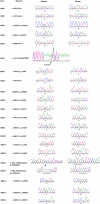Molecular analysis of Bardet-Biedl syndrome families: report of 21 novel mutations in 10 genes
- PMID: 21642631
- PMCID: PMC3176075
- DOI: 10.1167/iovs.11-7554
Molecular analysis of Bardet-Biedl syndrome families: report of 21 novel mutations in 10 genes
Abstract
Purpose: Bardet-Biedl syndrome (BBS) is genetically heterogeneous with 15 BBS genes currently identified, accounting for approximately 70% of cases. The aim of our study was to define further the spectrum of BBS mutations in a cohort of 44 European-derived American, 8 Tunisian, 1 Arabic, and 2 Pakistani families (55 families in total) with BBS.
Methods: A total of 142 exons of the first 12 BBS-causing genes were screened by dideoxy sequencing. Cases in which no mutations were found were then screened for BBS13, BBS14, BBS15, RPGRIP1L, CC2D2A, NPHP3, TMEM67, and INPP5E.
Results: Forty-three mutations, including 8 frameshift mutations, 10 nonsense mutations, 4 splice site mutations, 1 deletion, and 20 potentially or probably pathogenic missense variations, were identified in 46 of the 55 families studied (84%). Of these, 21 (2 frameshift mutations, 4 nonsense mutations, 4 splice site mutations, 1 deletion, and 10 missense variations) were novel. The molecular genetic findings raised the possibility of triallelic inheritance in 7 Caucasian families, 1 Arabian family, and 1 Tunisian patient. No mutations were detected for BBS4, BBS11, BBS13, BBS14, BBS15, RPGRIP1L, CC2D2A, NPHP3, TMEM67, or INPP5E.
Conclusions: This mutational analysis extends the spectrum of known BBS mutations. Identification of 21 novel mutations highlights the genetic heterogeneity of this disorder. Differences in European and Tunisian patients, including the high frequency of the M390R mutation in Europeans, emphasize the population specificity of BBS mutations with potential diagnostic implications. The existence of some BBS cases without mutations in any currently identified BBS genes suggests further genetic heterogeneity.
Figures


References
-
- Laurence JZ, Moon RC. Four cases of “retinitis pigmentosa” occurring in the same family and accompanied by general imperfection of development. Ophthal Rev. 1866;2:32–41 - PubMed
-
- Bardet G. Sur un syndrome d'obesite infantile avec polydactylie et retinite pigmentaire (contribution a l'etude des formes cliniques de l'obesite hypophysaire). 1920
-
- Biedl A. Ein Geschwisterpaar mit adiposo-genitaler Dystrophie. Dtsch. Med Wschr. 1922;48:1630–1630
-
- Rizzo JF, III, Berson EL, Lessell S. Retinal and neurologic findings in the Laurence-Moon-Bardet-Biedl phenotype. Ophthalmology. 1986;93:1452–1456 - PubMed
Publication types
MeSH terms
Substances
Grants and funding
LinkOut - more resources
Full Text Sources
Other Literature Sources

